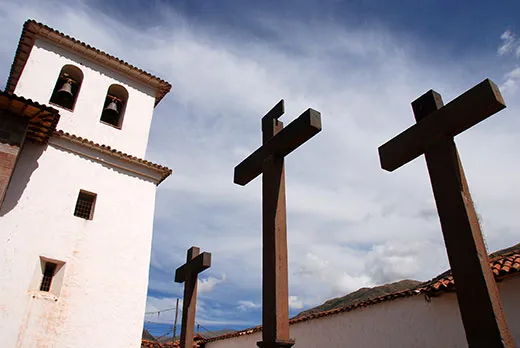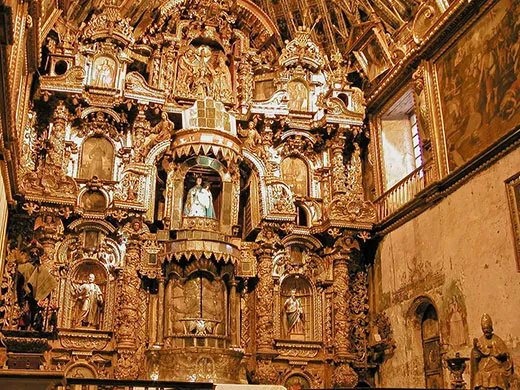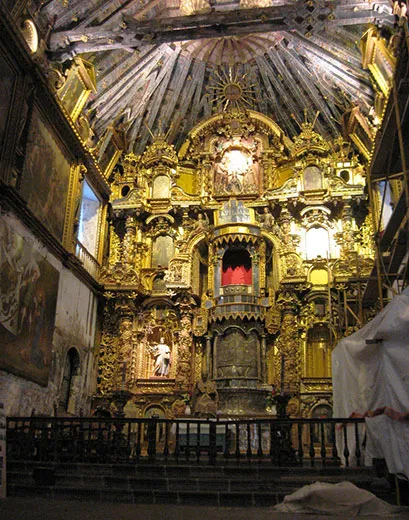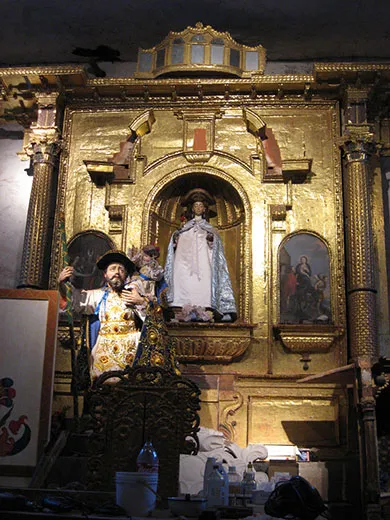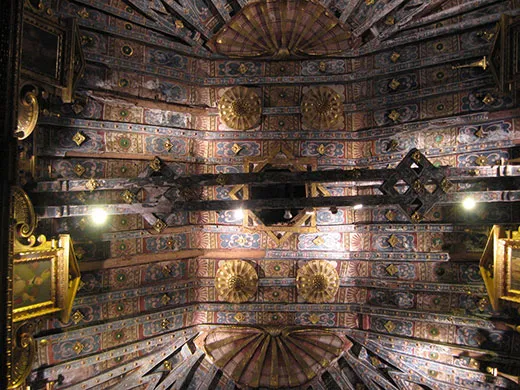The Sistine Chapel of the Andes
Just miles from Peru’s Incan ruins lie artifacts from another era—beautiful Baroque churches that married Spanish design with indigenous culture
/https://tf-cmsv2-smithsonianmag-media.s3.amazonaws.com/filer/San-Pedro-Apostol-church-Peru-interior-631.jpg)
Perched on a central square in the Andean village of Andahuaylillas, Peru, the whitewashed church of San Pedro Apóstol seems unremarkable at first. But inside is an eye-popping kaleidoscope—a dazzling display of colorful murals, a coffered painted ceiling and an ornate gold-leaf altar—earning it the moniker of “The Sistine Chapel of the Andes.” The Spanish began constructing the Baroque church in the late 16th century, as they cemented their conquest over the Inca Empire.
Most visitors to this part of Peru focus on Inca ruins—Cuzco is only 25 miles away—but its rural churches are worth a trip. An excursion to San Pedro and two other churches in neighboring Huaro and Canincunca sheds light on Peru’s often-overlooked artistic heritage.
Ready for a change after four days on the Inca trail, I hired a taxi in Cuzco and visited the churches one morning, traveling on the open roads of the Quispicanchi Valley and along cobbled village streets, where the pace of life is far slower than on the tourist circuit. In Andahuaylillas, I met Cara Caponi, an American Jesuit volunteer and amateur historian, who led me around all three churches. When she arrived in Peru several months ago, she knew little about these churches, but she’s devoted much effort to studying them and enjoys sharing her appreciation what she’s learned.
San Pedro has been under restoration since 2009, but its doors have stayed open. Locals trained at the fine arts school in Cuzco are cleaning the walls, conserving the paintings and strengthening the facade and roof. The roof of one of the side chapels had collapsed from water damage, destroying sections of the murals. The conservators have painted over the damaged portions in blue, so the remaining figures of angels and Christ peek out as if through a smudged window. The restoration, funded by the World Monuments Fund and the Spanish petroleum company Repsol, should be completed by the end of this year.
What sets the churches apart is the density of paintings, says Gauvin Bailey, author of The Andean Hybrid Baroque: Convergent Cultures in the Churches of Colonial Peru. Teams of itinerant Andean painters created the works largely in the 17th and 18th centuries. Murals were seen as an effective way to overcome language barriers to evangelize the Quechua-speaking population. San Pedro’s paintings abound with Christian allegories. At the church’s entrance, a busy tableau, inspired by the inferno, features a soul-eating monster breathing fire in hell, while angels in heaven guard against demons. Even the two organs in the choir loft are decorated, with angels playing instruments.
Especially fascinating, says Bailey, is how many indigenous symbols are tucked among Biblical ones—images of native plants, fruit and animals. Christian figures are arranged in ways that reflect Inca ideas of the cosmos; in the Annunciation scene painted in the chir, a hole in the wall represents the Holy Spirit and allows the sun to shine through. “Inti, the sun god, was the main Inca deity, so [the scheme] ties the two faiths together,” Bailey says.
But the Spanish didn’t build churches for religious reasons alone. Before they arrived, indigenous people lived off the land, and there were few villages. By building churches and squares, the Spanish created town centers, which made locals easier to govern. In Andahuaylillas, San Pedro is still a community hub. Caponi works at the parish soup kitchen, which feeds nearly 400 children a day, and there’s also an after-school program, library and legal services office, all supported in part from a nominal fee to see the church.
Entrance fees provide a major source of income for many parishes in Peru, and it’s hoped that a newly established Andean Baroque Route, linking churches across the country, will encourage more tourism. Though school groups and tourists throng to Andahuaylillas, not many stop by Huaro or Canincunca. Huaro’s San Juan Bautista, only a ten-minute drive from Andahuaylillas, finished its restoration in 2008. The town square looks untouched by modernity. With far fewer visitors than San Pedro, the church feels more peaceful and humble. The soft hues of its murals—pink, pale blue and white—give the nave an airy feel. San Juan Bautista’s murals are missing fragments, but what has been restored is sharp and vibrant. Most vivid are the nightmarish scenes of the Last Judgment in the entryway, the work of the 19th-century mestizo painter Tadeo Escalante. Naked bodies swirl against a fiery background, falling into caldrons and a monster’s mouth, while an angel blows bubbles that represent our mortality.
Our final stop was the chapel in Canincunca built in 1620. Dedicated to the Purified Virgin, patroness of travelers, it sits on a busy road overlooking the Urcos Lagoon. The spot was once a sacred site for the pre-Inca Wari people, and the frame around the chapel custodian’s door is decorated with a stone carving of the Wari spiral of life. We had to knock to get in, but the kindly man who opened the door assured us that visitors were welcome to disturb him anytime—almost no one does.
Inside, the ceiling is warped, a wall is bowed and most of the murals are faded. All that hints at the chapel’s former brilliance are the deep red walls by the entrance, covered with Andean motifs. Stylized vines crawl up the wall and big daisy-like blossoms peek down from the balcony. Even in their muted state, the murals are exuberant paeans to God and Pachamama (mother earth)—and a reward for whoever makes the trek.
Planning Your Next Trip?
Explore great travel deals
Smithsonian magazine participates in affiliate link advertising programs. If you purchase an item through these links, we receive a commission.
